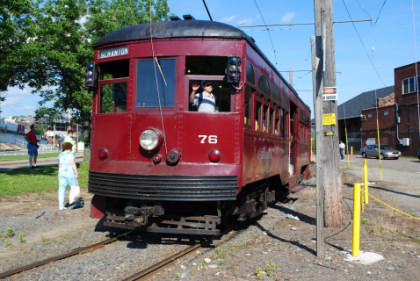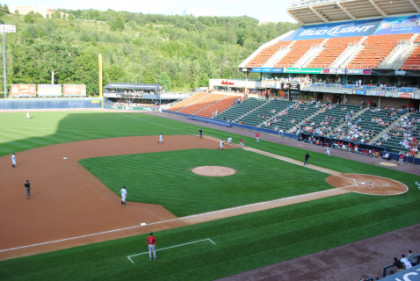


After the Stourbridge Line excursion, I walked over to the Wayne County Historical Society Museum where the Stourbridge Lion replica is displayed and paid $5 to see it.
This replica of the "Stourbridge Lion" was built by the Delaware & Hudson Railroad in 1932 from plans and parts of the original, which was the first steam locomotive to operate in the United States, and one of the first to operate outside Britain. Its name comes from the lion's face painted on the front, and the City of Stourbridge in England, where it was built by Foster, Rastrick & Company in 1828.
The company built only four steam locomotives. Three of them, the "Stourbridge Lion", the "Delaware" and the "Hudson" were ordered by Horatio Allen, a former co-worker of the Delaware & Hudson Canal Company’s Chief Engineer, John B. Jervis, while on a tour of the UK to investigate the new technology of steam locomotion. The D&H Canal Company was chartered in 1823 to build and operate canals between New York City and the coal fields around Carbondale, Pennsylvania. However, company engineers began thinking about rail transportation as early as 1825, and an initial plan was to build a railroad between the mines and the western end of the canal as a way to get the coal to the canal boats. Jervis proposed a series of gravity inclines connected by level sections to get the anthracite from the Wurts' mine in the Moosic Mountains near Carbondale to the canal at Honesdale.
Construction of the line started in 1826 and was completed in 1829. The three Rastrick engines arrived in New York in May 1829. A fourth locomotive ordered from the Robert Stephenson Company, named the "Pride of Newcastle", had already arrived a couple of months earlier, but it was the "Stourbridge Lion" that was first to operate. It was assembled at the West Point Foundry in New York where it was tested under steam in 1829 and then shipped out to Honesdale. The "Lion's" first official run took place there on 8th August that year.
The "Lion" performed well, although the track on which it ran was too light for the work. Jervis had specified the three locomotives should weigh no more than 4 tons, but the "Lion" weighed 7½ tons. With local locomotive manufacturers starting to produce improved designs as early as 1830, the four British engines were considered unsuitable and, by 1834, the D&H was trying to sell them to the Pennsylvania Canal Commission. However, the sale was never finalised and the locomotives were used as sources of English wrought-iron bar stock until the middle of the 1840's.
By 1845, all that was left of the "Lion" was its boiler, which was used in a foundry in Carbondale for about another five years until the foundry was sold a few years later.
The 1932 replica appeared at the 1933-34 Chicago World's Fair, the 1939-40 New York World's Fair and the Chicago Railroad Fair. It was subsequently loaned to Wayne County Historical Society where it remains to this day. The museum is located in a small brick building on Main Street, which was once the D&H Canal's company office, and is where the Stourbridge Lion began its inaugural run.
The new owners saw the boiler's value as a piece of history and reportedly tried selling it for $1,000 in 1874 but were unable to find a buyer. In 1883, the D&H borrowed the boiler to display at the Exposition of Railway Appliances in Chicago. Unfortunately, security around the boiler's transportation was lax and souvenir hunters pulled every loose item that they could off the now historic boiler. The boiler went into storage again and was eventually acquired by the Smithsonian Institution in 1890. It is now on loan to the Baltimore & Ohio Railroad Museum.
The first time I had seen this historic engine.
The locomotive's wheels.
Rear views.
Delaware & Hudson Canal Company gravity car 9 "The Eclipse" built in the 1880's.
I walked back to Bus 1 and it left within three minutes of me boarding. It was a quicker trip back to Scranton than this morning and I returned to the Radisson Hotel, showered and changed clothes before putting the camera's pictures from today's trip into the computer and uploading them. I then walked towards the Hilton but saw the group already walking over to the trolley for our trip to the ballgame between the Pawtucket Red Sox verses the Scranton/Wilkes Barre Yankees.
The group boarding Trolley 76.

Philadelphia Suburban Transportation Company trolley 76 built by J.G. Brill in 1926 is a "Center Door" car originally built for the predecessor the Philadelphia and West Chester Traction Company. It was the highest-numbered car of a 32-car fleet of such cars bought in three orders, starting in 1919. These crowd-swallowing trolleys roamed the "Red Arrow Lines" system from 69th Street Terminal in Upper Darby to suburban terminals in West Chester, Ardmore, Media and Sharon Hill. As more modern cars arrived over the years, the remaining large, heavy Center Door cars were relegated to rush-hour "tripper" service, school trips, and winter operation to keep the lines clear of snow. Car 76 was retired in 1976.
Our route would be over the old Laurel Line which was 19 miles long and connected Scranton with Wilkes Barre.
The Lackawanna Station tower before we left our boarding location.
The interior of the trolley.
Maid-Rite Steak Company in the former Lackawanna and Wyoming Valley (Laurel Line) freight house.
Our trip to the Ballpark started.
The old Laurel Line Freighthouse.
Looking back.
Siding to another boarding platform.
We ran along a creek in a concrete channel.
Looking back with the Lackawanna Radisson in this view.
The Delaware-Lackawanna Railroad serves this pellet industry.
An old coal mine along the route.
View looking back.
We crossed the Roaring Brook.
The train entered the mile-long Laurel Line Crown Avenue Tunnel, which at 4,747 feet long, is one of the longest interurban tunnels ever built.
Exiting the tunnel.
We then entered and passed through this modern tunnel.
Our trolley went under Interstate 81.
Views looking behind.
We crossed a little creek.
Rounding this curve.
Crossing another little creek.
Looking back.
This siding is used as a run-around track.
Another small creek bridge.
This track leads to a switchback up the hill to the major industry on the line.
The former Erie Rairoad line which was the same one we rode in Honesdale earlier in the day.
Views looking back.
We curved off the freight line to go on the trolley-only line to PNC Park.
There were tight curves along this part of the line.
The Lackawanna Visitor Center is built like a train station.
More tight curves took us up the hill to PNC Park where we detrained. Everyone else was given a tour of the car barn while I walked over to PNC Park and found that our tickets were in the Third Base Party Box.
PNC Park in Scranton.
Just before the game started.

The first out of the game.
Our group in the Third Base party box.
I worked on my stories while I watched the game and the ballpark also offered wireless Internet so I could upload them when completed.
The Mascot Champ visited us in the Third Base Party Box. The Red Sox beat the Yankees by a score of 7-6, after which everyone returned to the trolley for the return trip to Scranton. From there we all walked back to our hotels for the night.
The Electric City neon sign looked very good outside my window tonight.
| RETURN TO THE MAIN PAGE |